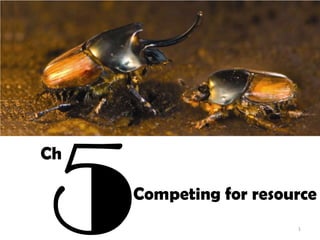Ch05 competing for resource
- 2. Evolutionaryily Stable Strategy(ESS) č▌╗»ĘĆČ©▓▀┬į (Smith & Price, 1973) A strategy that was adopted by all members of a population, cannot be bettered by alternative strategy. ESS 2
- 3. The Hawk-Dove game Each strategy does best when it is relatively rare. 3
- 4. The stable mixture V<C h = the proportion of Hawks in population H average= -25h + 50 (1-h) D average= 0 h + 25 (1-h) h = 1/2 In V<C ? V/C (the stable proportion of Hawks) If V>C, then Hawk is an ESS! 4
- 5. Competition by exploitation : the ideal free distribution The ideal free model └ĒŽļūįė╔─Żą═ (Fretwell, 1972) «ö┘Yį┤žSĖ╗Ą─Ś½Ąžį┌ėąaéĆĖé ĀÄš▀Ą─ŪķørŽ┬Ż¼éĆ¾wł¾│ĻĢ■┌ģ Į³ņČĖéĀÄš▀▌^╔┘Ą─Ą═┘Yį┤Ś½ĄžĪŻ Fig. 5.1 The ideal free distribution. 5
- 6. Which line will you choose? 6
- 7. Competition by exploitation : the ideal free distribution Competing for food: sticklebacks and ducks 7
- 8. Competing for food: sticklebacks (Milinski, 1979) 8
- 10. Competing for food: Ducks (Harper, 1982) N=33 10
- 11. Fish and Ducks settle in a stable distribution between feeding patches. Numerical prediction öĄųĄŅA£y Equal intake prediction Ą╚┴┐öz╚ĪŅA£y Prey risk prediction ½C╬’’LļUŅA£y 11
- 12. Competing for mates: dung flies What is the optimum time to spend waiting for females at each cowpat? 12
- 13. Fig. 5.3 ┼Ż╝S╔ŽĄ─ą█╝SŽēöĄ┴┐Ģ■ ļSų°ĢrķgĄ─į÷╝ėČ°£p╔┘ į┌▓╗═¼Ą─Ą╚┤²ĢrķgŻ¼ ą█╝SŽēĄ─Į╗┼õ│╔╣”┬╩Įįę╗ų┬ Males adopt evolutionarily stable waiting times. (Parker, 1970) 13
- 14. Competition by resource defence : the despotic distribution īŻÖMĄ─Ęųüč Fig. 5.4 (Brown, 1969) 14
- 15. The ideal free distribution with unequal competitors 2:1 The Competitive unit model (Parker & Sutherland, 1986) Hypothesis: the number of competitive units , rather than the number of individual, is equalized across patches. 8:4 8:4 Fig. 5.5 15
- 16. Habitat Selection in Gill aphid (Whitham, 1978) ╚~Ų¼├µĘe šŁ╚~ŚŅ ├┐ļb┤Ųč┴ŽxĄ─ūė┤·öĄ Ę▒ų││╔╣”┬╩į┌▓╗═¼öĄ┴┐ Ą─ĖéĀÄš▀Įį¤o’@ų°▓Ņ«É Fig. 5.6 ├┐Ų¼╚~ūė╔ŽĄ─┤Ųč┴ŽxöĄ 16
- 17. Leaf is not a homogeneous habitat. Average success is equal on leaves of different quality, but individuals near the leaf base do better. 17
- 18. The economics of resource defence Economic defendability ĮøØ·Ą─┐╔Ę└ČRąį (Brown, 1964) Fig. 5.7 18
- 19. Box 5.1 The Economics of territory defence in the Golden-Winged sunbird (Gill & Wolf, 1975) Metabolic costs Forage time Net energy saving of defending Extra cost of defence 19
- 20. The economics of resource defence Shared resource defence ┘Yį┤Ą─╣▓═¼Ę└ČR With satellite NO satellite With satellite Fig. 5.8 20
- 21. Producers and scroungers ╔·«aš▀┼c═ČÖCš▀ Fig. 5.9 Make the best of a bad job. 21
- 22. The variable foraging techniques of ruddy turnstone (Whitfield, 1990) Routing expose prey Hammering barnacles Stone turning Surface pecking Digging Probing 22
- 24. Variation could also be maintained in a population even if there was no difference in competitive ability between individuals. 24
- 25. The stable equilibrium frequency of producers and scroungers Covered (Mottley & Giraldeau, 2000) Uncovered pridected stable equilibrium 25
- 26. Alternative mating strategies and tactics ╠µ┤·Ą─Į╗┼õ▓▀┬į┼cæąg Strategy A genetically based decision rule, so differences between strategies are due to differences in gene. Tactic A behaviour pattern played as part of a strategy. 26
- 27. Conditional strategies with alternative tactics Natterjack toads: callers & satellites (Arak, 1983) ā╔▒Č callers satellites Fig. 5.11 27
- 28. Satellite males make adaptive choice concerning which callers to parasitize. Fig. 5.12 28
- 29. Morphological switches with body size: dung beetles and earwigs Fig. 13 29
- 30. Fig. 5.14 30
- 31. The threshold morphological switch between alternative within a conditional strategy. (Gross, 1996) (Hunt & Smon, 2001) ķōųĄ Fig. 5.15 31
- 32. Use selection experiment shows : Threshold has a genetic basis (Emlen, 1996) Fig. 5.16 32
- 33. forceps How selection has shifted a threshold switch in morphology (Tomkins & Brown, 2004) Knoxes Reef Bass Rock B K K B (▒▒║Ż╔Ž22éĆŹu╔ŽĄ─ĮY╣¹) ForceptūāķL─▄▒ŻūoįĮČÓ┤Ųąį 33
- 34. Alternative strategies: equilibria and cycles ŲĮ║Ō┼c裣h Fitness ģó┐╝fig.5.9 (b) Proportion of scroungers 34
- 35. Ruffs: fighters, satellites and female mimics 35
- 36. A marine isopod with three male morphs alpha beta gamma Each male morph gains equal success. 36
- 37. Side-blotched lizards: cycles of orange, blue and yellow 37
- 38. Thanks for your Listening 38






































